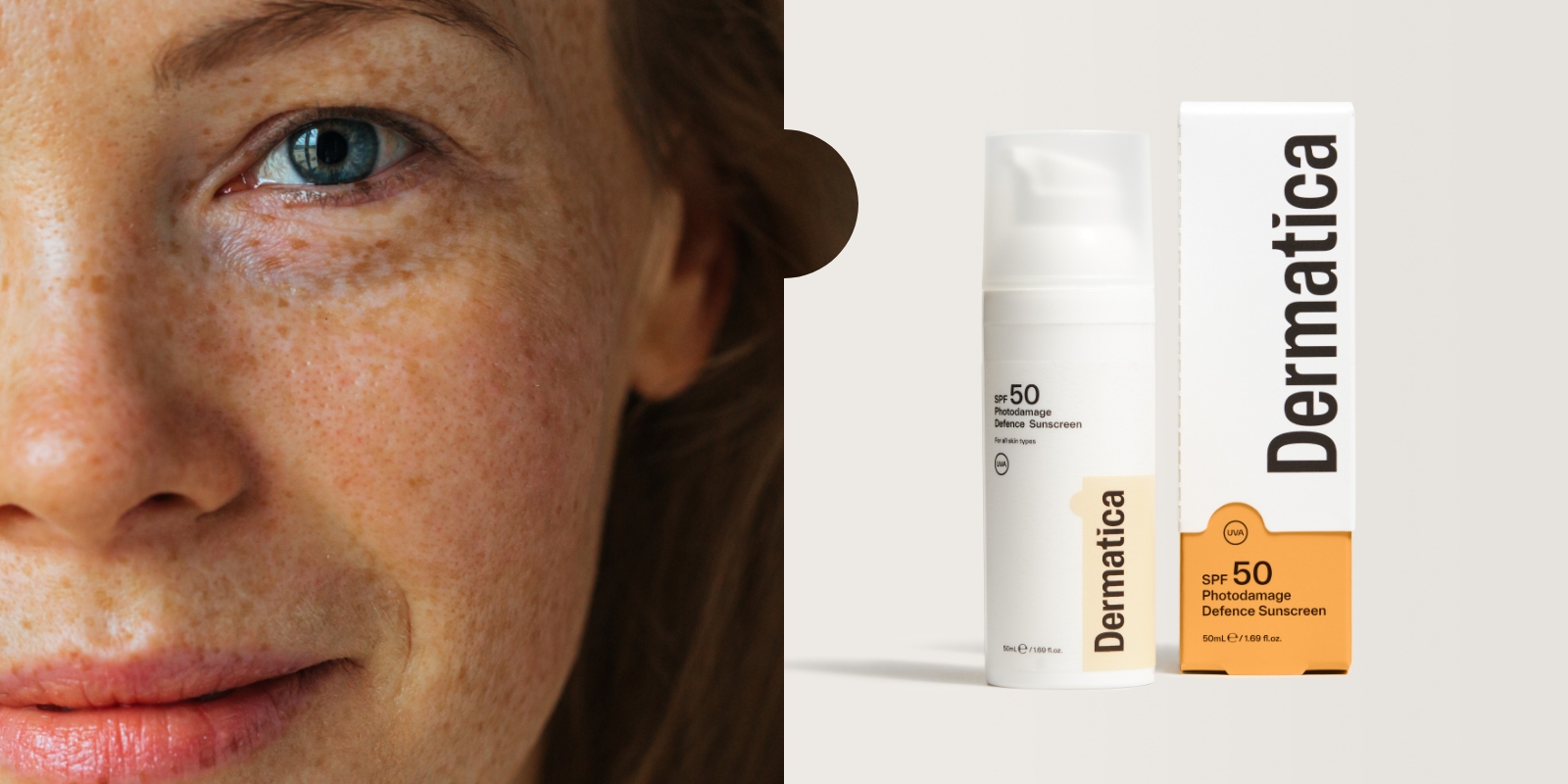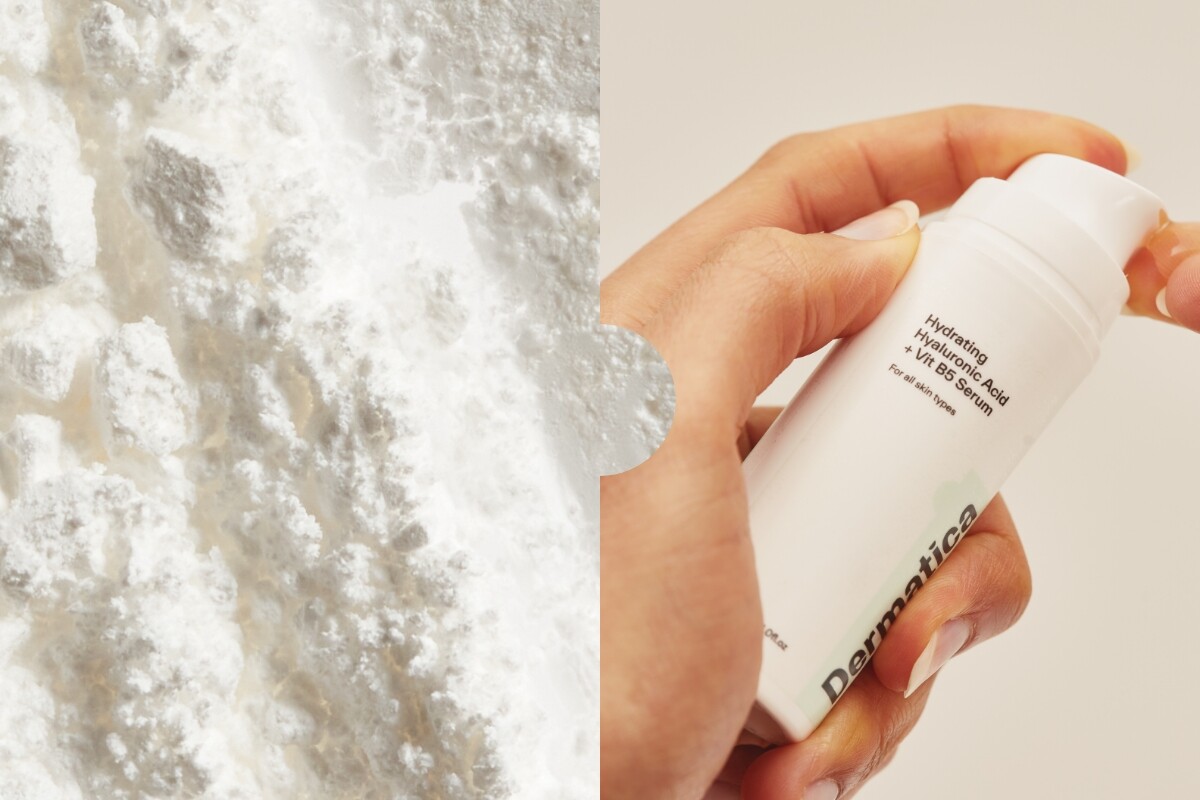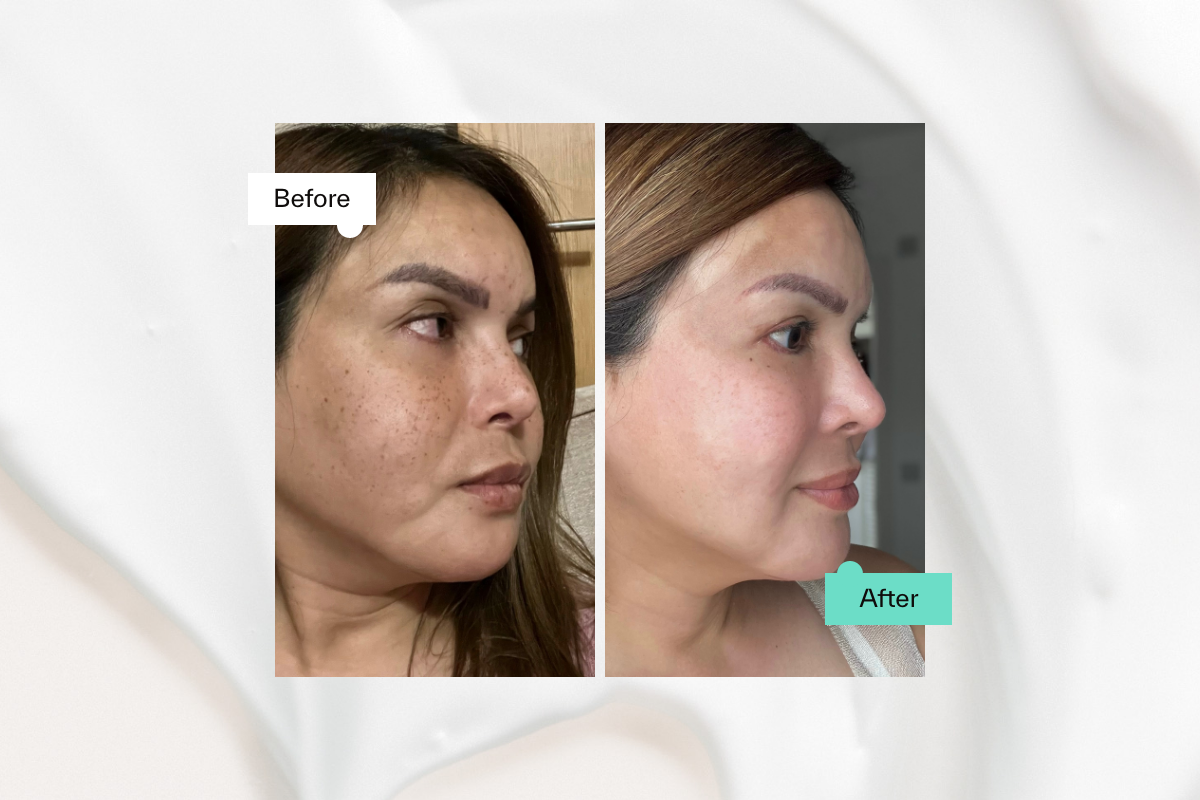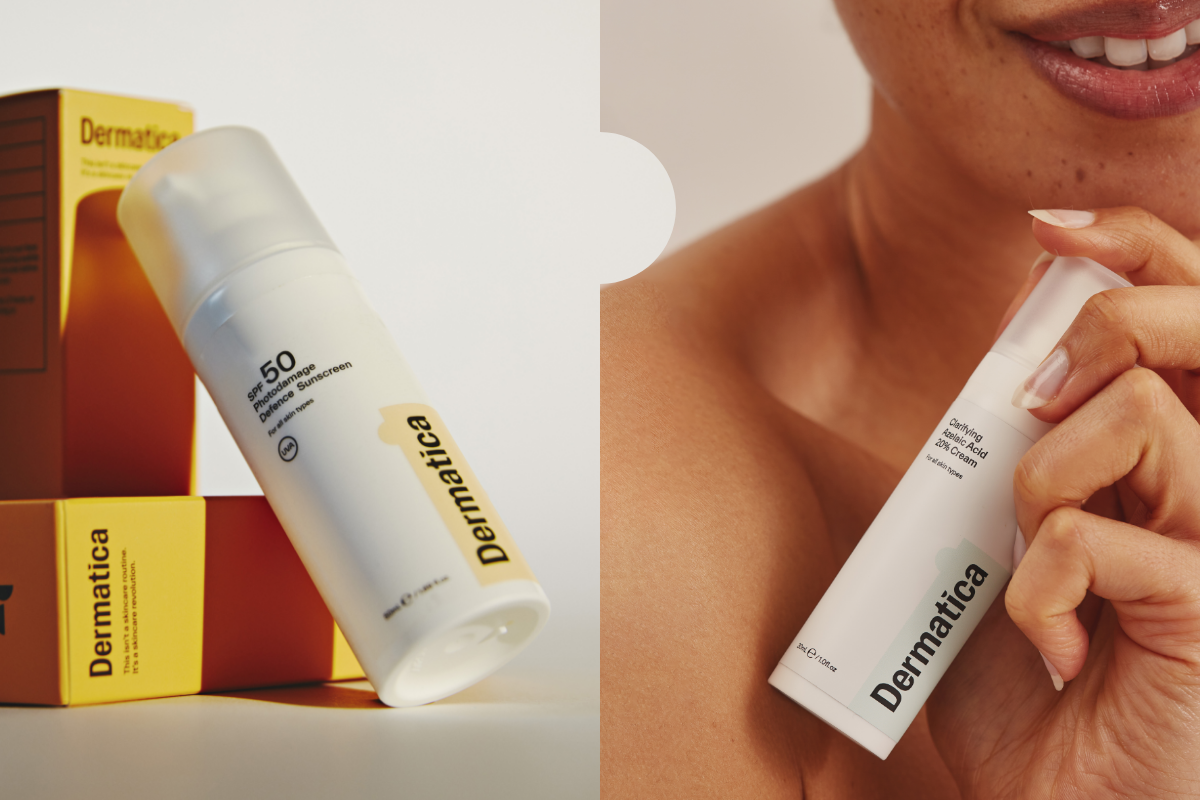Hyperpigmentation (the medical term to describe uneven skin tone) includes dark spots, sun spots, melasma and post-inflammatory hyperpigmentation, and can have a big impact on a person’s confidence and self-esteem. (1) Uneven skin tone can be improved using either prescription or over the counter treatments. However, this condition can take a while to treat, and without taking the right steps it can come back. At Dermatica, we recommend taking the time to really understand how to get the best from your treatment. There are also a number of seemingly quick wins and techniques which can slow your progress or indeed damage the skin.
Read on for every mistake to avoid before tackling your own dark patches.
Forgetting About Sun Protection
There isn’t a dermatologist at Dermatica that doesn’t recommend using sunscreen daily. It’s even more important to us when you have dark spots, because sunscreen prevents them from darkening or coming back.
Daily broad-spectrum sunscreen should be your first step to stop dark patches from getting worse and to improve the appearance of uneven skin. (2) Both chemical and mineral sunscreens with at least SPF30+ will help protect your skin, but ones with a higher UV protection like our SPF50 Photodamage Defence Sunscreen are even better. Our experts also urge you to stay in the shade and cover up your skin with long-sleeved clothing and a wide brimmed hat. (3)
Expecting Results Right Away
Treating uneven skin tone is possible – but don’t worry if you don’t see results straight away – our subscribers often find it can take some time.
Your treatment needs to penetrate deep into the base of your epidermis, where our skin’s pigment (melanin) is produced, to have an effect. It also takes around four weeks for cells at the bottom of the epidermis to reach the surface of your skin and shed. This is called a skin cycle. It can take more than one skin cycle for your treatment to have a noticeable effect. (4)
This is why most Dermatica subscribers start to see results after eight weeks or so. It may take longer if these areas get retriggered by UV exposure from the sun. For more stubborn dark patches it may take even longer. Although it can feel frustrating, improving your skin tone is definitely a marathon not a sprint, so try to be patient – the results will be worth it.
Ignoring Irritation
If your skin stings after you apply a treatment, we know it can be tempting to power through and keep going. However, more isn’t always better. If you’re experiencing persistent or painful side effects that are hot to the touch, itch or hurt, stop.
Here at Dermatica, we like to say that a slight tingle is fine but there’s no such thing as a good sting. What’s more, some uneven skin tone can be caused by inflammation (like rashes, wounds or breakouts) – so ignoring irritation could actually make your uneven skin tone worse. To combat this, our dermatology experts always recommend:
– Introducing active treatments one by one. Once your skin tolerates it well, you can try adding another one. Don’t overload your skin with active ingredients, too many can be very irritating.
– If daily use is too much, apply it less regularly. Skip a day or two, or reduce how often you use it to one to two times a week.
– Notice a strong reaction or find it painful? Pause that product immediately until your skin is healed.
If you’re a Dermatica subscriber and you aren’t sure whether your irritation is normal, reach out to our friendly team anytime through your dashboard. We’re here for you, always.
Focusing Solely On Tyrosinase Inhibitors
To produce the pigment in our skin, an enzyme called tyrosinase works within our melanocytes (the skin cells responsible for making our skin’s pigment). When the tyrosinase and melanocytes are overstimulated by something like UV rays or hormones, too much melanin is produced, causing hyperpigmentation. (5)
Read more from our experts about why some people get hyperpigmentation.
Tyrosinase inhibitors like prescription hydroquinone and retinoids are ingredients that help slow down this process. To reach the areas causing uneven skin tone, these ingredients need to be at the right molecular weights and sizes. For the best treatments, look for evidence-based products backed by clinical data on real people, or speak to a licensed dermatology expert. They can personalise a treatment that suits your skin goals. (6)
Using Illegal Bleaching Creams
In the UK and the US – regulators impose restrictions on harmful ingredients to make sure our cosmetic products and medicines are safe. This prevents skincare products like dangerous bleaching creams from entering the country, as these have been found to have unsafe strengths of active ingredients like hydroquinone inside, or to contain steroids and even mercury. (7)
Read more about how we use hydroquinone safely for hyperpigmentation at Dermatica.
While we all know the dangers of mercury exposure and poisoning, unprescribed steroids also pose a danger to the skin. In the short-term they can cause pimples and rashes, and long-term they can thin the skin, causing sensitivity or permanently discolouring areas. (8)
Using Medications That Can Cause Hyperpigmentation
Some medications like oral contraceptives and drugs that cause sensitivity to UV light could be causing your uneven skin tone, or making it more difficult to treat. (9)
Before you start tackling hyperpigmentation, we recommend looking into whether it may be caused by your medication. If you’re a subscriber, you can speak to our dermatology experts about whether the side effects line up with your symptoms, and how your medication might affect a personalised skincare formula or prescription. It’s best to speak to your prescribing doctor about whether there are suitable alternatives so it doesn’t get in the way of fading your uneven skin tone.
If you’d like to fade hyperpigmentation using science-backed skincare solutions, you can read more about creating a skincare routine to suit your skin’s needs here, or visit our website to find out which formulas are suitable for your skin.
References
1. Thawabteh AM, Jibreen A, Karaman D, Thawabteh A, Karaman R. Skin Pigmentation Types, Causes and Treatment—A Review. Molecules [Internet]. 2023 Jun 18;28(12):4839. Available from: https://www.mdpi.com/1420-3049/28/12/4839
2. Hamzavi I, Fatima S, Braunberger T, Mohammad T, Kohli I. The role of sunscreen in melasma and postinflammatory hyperpigmentation. Indian Journal of Dermatology [Internet]. 2020;65(1):5. Available from: https://www.ncbi.nlm.nih.gov/pmc/articles/PMC6986132/
3. Pillaiyar T, Manickam M, Namasivayam V. Skin whitening agents: medicinal chemistry perspective of tyrosinase inhibitors. Journal of Enzyme Inhibition and Medicinal Chemistry [Internet]. 2017 Jan;32(1):403–25. Available from: https://www.ncbi.nlm.nih.gov/pmc/articles/PMC6010116/
4. Information NC for B, Pike USNL of M 8600 R, MD B, Usa 20894. How does skin work? [Internet]. www.ncbi.nlm.nih.gov. Institute for Quality and Efficiency in Health Care (IQWiG); 2019. Available from: https://www.ncbi.nlm.nih.gov/books/NBK279255/
5. Gabros S, Zito PM. Sunscreens And Photoprotection [Internet]. Nih.gov. StatPearls Publishing; 2019. Available from: https://www.ncbi.nlm.nih.gov/books/NBK537164/
6. Zolghadri S, Bahrami A, Hassan Khan MT, Munoz-Munoz J, Garcia-Molina F, Garcia-Canovas F, et al. A comprehensive review on tyrosinase inhibitors. Journal of Enzyme Inhibition and Medicinal Chemistry. 2019 Jan;34(1):279–309.
7. How to fade dark spots in darker skin tones [Internet]. www.aad.org. Available from: https://www.aad.org/public/everyday-care/skin-care-secrets/routine/fade-dark-spots
8. Pollock S. The Dark Side of Skin Lightening: An International Collaboration and Review of a Public Health Issue Affecting Dermatology. International Journal of Women’s Dermatology [Internet]. 2020 Sep 17;7(2). Available from: https://www.sciencedirect.com/science/article/pii/S2352647520301416
9. Hyperpigmentation: Age Spots, Sun Spots & Liver Spots [Internet]. Cleveland Clinic. Available from: https://my.clevelandclinic.org/health/diseases/21885-hyperpigmentation





